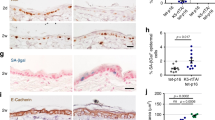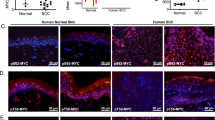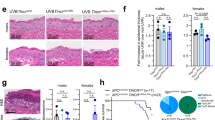Abstract
Genetic experiments established that p63 is crucial for the development and maintenance of pluri-stratified epithelia and KLF4 for the barrier function of the skin. KLF4 is one of the factors that reprogram differentiated cells to iPS. We investigated the relationship between p63 and KLF4 using RNA interference, overexpression, chromatin immunoprecipitation and transient transfections with reporter constructs. We find that p63 directly represses KLF4 in normal keratinocytes (KCs) by binding to upstream promoter sites. Unlike p63, KLF4 levels are high in the upper layers of human skin and increase upon differentiation of KCs in vitro. In HaCaT KCs, which harbor two mutant alleles of p53, inactivation of p63 and of mutant p53 leads to KLF4 repression. p63 and p53 mutants are bound to sites in the KLF4 core promoter. Importantly, expression of the H179Y and R282Q p53 mutants in primary KCs is sufficient to activate endogenous KLF4. Finally, immunohistochemical analysis of tissue arrays confirms increased coexpression of KLF4 and mutant p53 in squamous cell carcinomas. Our data indicate that suppression of KLF4 is part of the growth-promoting strategy of p63 in the lower layers of normal epidermis, and that tumor-predisposing p53 mutations hijack p63 to a different location on the promoter, turning it into an activator of this reprogramming factor.
This is a preview of subscription content, access via your institution
Access options
Subscribe to this journal
Receive 50 print issues and online access
$259.00 per year
only $5.18 per issue
Buy this article
- Purchase on Springer Link
- Instant access to full article PDF
Prices may be subject to local taxes which are calculated during checkout





Similar content being viewed by others
References
Aylon Y, Oren M . (2007). Living with p53, dying of p53. Cell 130: 597–600.
Barbaro V, Testa A, Di Iorio E, Mavilio F, Pellegrini G, De Luca M . (2007). C/EBPdelta regulates cell cycle and self-renewal of human limbal stem cells. J Cell Biol 177: 1037–1049.
Barbieri CE, Tang LJ, Brown KA, Pietenpol JA . (2006). Loss of p63 leads to increased cell migration and up-regulation of genes involved in invasion and metastasis. Cancer Res 66: 7589–7597.
Boukamp P, Popp S, Altmeyer S, Hülsen A, Fasching C, Cremer T et al. (1997). Sustained nontumorigenic phenotype correlates with a largely stable chromosome content during long-term culture of the human keratinocyte line HaCaT. Genes Chromosomes Cancer 19: 201–214.
Brosh R, Rotter V . (2009). When mutants gain new powers: news from the mutant p53 field. Nat Rev Cancer 9: 701–713.
Carroll DK, Brugge JS, Attardi LD . (2007). p63, cell adhesion and survival. Cell Cycle 6: 255–261.
Carroll DK, Carroll JS, Leong CO, Cheng F, Brown M, Mills AA et al. (2006). p63 regulates an adhesion programme and cell survival in epithelial cells. Nat Cell Biol 8: 551–561.
Chen X, Johns DC, Geiman DE, Marban E, Dang DT, Hamlin G et al. (2001). Kruppel-like factor 4 (gut-enriched Kruppel-like factor) inhibits cell proliferation by blocking G1/S progression of the cell cycle. J Biol Chem 276: 30423–30428.
Chen X, Whitney EM, Gao SY, Yang VW . (2003). Transcriptional profiling of Kruppel-like factor 4 reveals a function in cell cycle regulation and epithelial differentiation. J Mol Biol 326: 665–677.
Chen YJ, Wu CY, Chang CC, Ma CJ, Li MC, Chen CM . (2008). Nuclear Krüppel-like factor 4 expression is associated with human skin squamous cell carcinoma progression and metastasis. Cancer Biol Ther 7: 777–782.
Conkright MD, Wani MA, Anderson KP, Lingrel JB . (1999). A gene encoding an intestinal-enriched member of the Kruppel-like factor family expressed in intestinal epithelial cells. Nucleic Acids Res 27: 1263–1270.
Dai X, Segre JA . (2004). Transcriptional control of epidermal specification and differentiation. Curr Opin Genet Dev 14: 485–491.
Dang DT, Zhao W, Mahatan CS, Geiman DE, Yang VW . (2002). Opposing effects of Kruppel-like factor 4 (gut-enriched Kruppel-like factor) and Krüppel-like factor 5 (intestinal-enriched Kruppel-like factor) on the promoter of the Krüppel-like factor 4 gene. Nucleic Acids Res 30: 2736–2741.
Datto MB, Li Y, Panus JF, Howe DJ, Xiong Y, Wang XF . (1995). Transforming growth factor beta induces the cyclin-dependent kinase inhibitor p21 through a p53-independent mechanism. Proc Natl Acad Sci USA 92: 5545–5549.
Davison TS, Vagner C, Kaghad M, Ayed A, Caput D, Arrowsmith CH . (1999). p73 and p63 are homotetramers capable of weak heterotypic interactions with each other but not with p53. J Biol Chem 274: 18709–18714.
de Gruijl FR, Rebel H . (2008). Early events in UV carcinogenesis: DNA damage, target cells and mutant p53 foci. Photochem Photobiol 84: 382–387.
Deyoung MP, Ellisen LW . (2007). p63 and p73 in human cancer: defining the network. Oncogene 26: 5169–5183.
Di Como CJ, Gaiddon C, Prives C . (1999). p73 function is inhibited by tumor-derived p53 mutants in mammalian cells. Mol Cell Biol 19: 1438–1449.
Di Agostino S, Strano S, Emiliozzi V, Zerbini V, Mottolese M, Sacchi A et al. (2006). Gain of function of mutant p53: the mutant p53/NF-Y protein complex reveals an aberrant transcriptional mechanism of cell cycle regulation. Cancer Cell 10: 191–202.
Donzelli S, Biagioni F, Fausti F, Strano S, Fontemaggi G, Blandino G . (2008). Oncogenomic approaches in exploring gain of function of mutant p53. Curr Genomics 9: 200–207.
Foster KW, Frost AR, McKie-Bell P, Lin CY, Engler JA, Grizzle WE et al. (2000). Increase of GKLF messenger RNA and protein expression during progression of breast cancer. Cancer Res 60: 6488–6495.
Foster KW, Liu Z, Nail CD, Li X, Fitzgerald TJ, Bailey SK et al. (2005). Induction of KLF4 in basal keratinocytes blocks the proliferation-differentiation switch and initiates squamous epithelial dysplasia. Oncogene 24: 1491–1500.
Foster KW, Ren S, Louro ID, Lobo-Ruppert SM, McKie-Bell P, Grizzle W et al. (1999). Oncogene expression cloning by retroviral transduction of adenovirus E1A-immortalized rat kidney RK3E cells: transformation of a host with epithelial features by c-MYC and the zinc finger protein GKLF. Cell Growth Differ 10: 423–434.
Furlan-Magaril M, Rincón-Arano H, Recillas-Targa F . (2009). Sequential chromatin immunoprecipitation protocol: ChIP-reChIP. Methods Mol Biol 543: 253–266.
Gaiddon C, Lokshin M, Ahn J, Zhang T, Prives C . (2001). A subset of tumor-derived mutant forms of p53 down-regulate p63 and p73 through a direct interaction with the p53 core domain. Mol Cell Biol 21: 1874–1887.
Garrett-Sinha LA, Eberspaecher H, Seldin MF, de Crombrugghe B . (1996). A gene for a novel zinc-finger protein expressed in differentiated epithelial cells and transiently in certain mesenchymal cells. J Biol Chem 271: 31384–31390.
Ghaleb AM, Katz JP, Kaestner KH, Du JX, Yang VW . (2007). Kruppel-like factor 4 exhibits antiapoptotic activity following gamma-radiation-induced DNA damage. Oncogene 26: 2365–2373.
Ghaleb AM, Nandan MO, Chanchevalap S, Dalton WB, Hisamuddin IM, Yang VW et al. (2005). Kruppel-like factors 4 and 5: the yin and yang regulators of cellular proliferation. Cell Res 15: 92–96.
Jiang W, Ananthaswamy HN, Muller HK, Kripke ML . (1999). p53 protects against skin cancer induction by UV-B radiation. Oncogene 18: 4247–4253.
Jaubert J, Cheng J, Segre JA . (2003). Ectopic expression of kruppel like factor 4 (Klf4) accelerates formation of the epidermal permeability barrier. Development 130: 2767–2777.
Hong H, Takahashi K, Ichisaka T, Aoi T, Kanagawa O, Nakagawa M et al. (2009). Suppression of induced pluripotent stem cell generation by the p53-p21 pathway. Nature 460: 1132–1135.
Huang CC, Liu Z, Li X, Bailey SK, Nail CD, Foster KW et al. (2005). KLF4 and PCNA identify stages of tumor initiation in a conditional model of cutaneous squamous epithelial neoplasia. Cancer Biol Ther 4: 1401–1408.
Kaczynski J, Cook T, Urrutia R . (2003). Sp1- and Krüppel-like transcription factors. Genome Biol 4: 206.
Kato S, Han SY, Liu W, Otsuka K, Shibata H, Kanamaru R et al. (2003). Understanding the function-structure and function-mutation relationships of p53 tumor suppressor protein by high-resolution missense mutation analysis. Proc Natl Acad Sci USA 100: 8424–8429.
Kawamura T, Suzuki J, Wang YV, Menendez S, Morera LB, Raya A et al. (2009). Linking the p53 tumour suppressor pathway to somatic cell reprogramming. Nature 460: 1140–1144.
Koster MI, Roop DR . (2004). p63 and epithelial appendage development. Differentiation 72: 364–370.
Li G, Tron V, Ho V . (1998). Induction of squamous cell carcinoma in p53-deficient mice after ultraviolet irradiation. J Invest Dermatol 110: 72–75.
Malkin D, Li FP, Strong LC, Fraumeni Jr JF, Nelson CE, Kim DH et al. (1990). Germ line p53 mutations in a familial syndrome of breast cancer, sarcomas, and other neoplasms. Science 250: 1233–1238.
Marión RM, Strati K, Li H, Murga M, Blanco R, Ortega S et al. (2009). A p53-mediated DNA damage response limits reprogramming to ensure iPS cell genomic integrity. Nature 460: 1149–1153.
McKeon F . (2004). p63 and the epithelial stem cell: more than status quo? Genes Dev 18: 465–469.
Mills AA, Zheng B, Wang XJ, Vogel H, Roop DR, Bradley A . (1999). p63 is a p53 homologue required for limb and epidermal morphogenesis. Nature 398: 708–713.
Ortt K, Sinha S . (2006). Derivation of the consensus DNA-binding sequence for p63 reveals unique requirements that are distinct from p53. FEBS Lett 580: 4544–4550.
Pfeifer GP, Besaratinia A . (2009). Mutational spectra of human cancer. Hum Genet 125: 493–506.
Perez CA, Pietenpol JA . (2007). Transcriptional programs regulated by p63 in normal epithelium and tumors. Cell Cycle 6: 246–254.
Pozzi S, Zambelli F, Merico D, Pavesi GX, Robert A, Maltère P et al. (2009). Transcriptional network of p63 in human keratinocytes. PLoS ONE 4: e5008.
Riley T, Sontag E, Chen P, Levine A . (2008). Transcriptional control of human p53-regulated genes. Nat Rev Mol Cell Biol 9: 402–412.
Rinne T, Hamel B, van Bokhoven H, Brunner HG . (2006). Pattern of p63 mutations and their phenotypes—update. Am J Med Genet A 140: 1396–1406.
Rowland BD, Bernards R, Peeper DS . (2005). The KLF4 tumour suppressor is a transcriptional repressor of p53 that acts as a context-dependent oncogene. Nat Cell Biol 7: 1074–1082.
Segre JA, Bauer C, Fuchs E . (1999). Klf4 is a transcription factor required for establishing the barrier function of the skin. Nat Genet 22: 356–360.
Senoo M, Pinto F, Crum CP, McKeon F . (2007). p63 Is essential for the proliferative potential of stem cells in stratified epithelia. Cell 129: 523–536.
Shields JM, Christy RJ, Yang VW . (1996). Identification and characterization of a gene encoding a gut-enriched Kruppel-like factor expressed during growth arrest. J Biol Chem 271: 20009–20017.
Smith C, Zhu K, Merritt A, Picton R, Youngs D, Garrod D et al. (2004). Regulation of desmocollin gene expression in the epidermis: CCAAT/enhancer-binding proteins modulate early and late events in keratinocyte differentiation. Biochem J 380: 757–765.
Stambolsky P, Tabach Y, Fontemaggi G, Weisz L, Maor-Aloni R, Siegfried Z et al. (2010). Modulation of the vitamin D3 response by cancer-associated mutant p53. Cancer Cell 17: 273–285.
Strano S, Munarriz E, Rossi M, Cristofanelli B, Shaul Y, Castagnoli L et al. (2000). Physical and functional interaction between p53 mutants and different isoforms of p73. J Biol Chem 275: 29503–29512.
Su X, Paris M, Gi YJ, Tsai KY, Cho MS, Lin YL et al. (2009). TAp63 prevents premature aging by promoting adult stem cell maintenance. Cell Stem Cell 5: 64–75.
Swamynathan SK, Davis J, Piatigorsky J . (2008). Identification of candidate Klf4 target genes reveals the molecular basis of the diverse regulatory roles of Klf4 in the mouse cornea. Invest Ophthalmol Vis Sci 49: 3360–3370.
Swamynathan SK, Katz JP, Kaestner KH, Ashery-Padan R, Crawford MA, Piatigorsky J . (2007). Conditional deletion of the mouse Klf4 gene results in corneal epithelial fragility, stromal edema, and loss of conjunctival goblet cells. Mol Cell Biol 27: 182–194.
Takahashi K, Yamanaka S . (2006). Induction of pluripotent stem cells from mouse embryonic and adult fibroblast cultures by defined factors. Cell 126: 663–676.
Testoni B, Borrelli S, Tenedini E, Alotto D, Castagnoli C, Piccolo S et al. (2006). Identification of new p63 targets in human keratinocytes. Cell Cycle 5: 2805–2811.
Tsai KY, Tsao H . (2004). The genetics of skin cancer. Am J Med Genet C Semin Med Genet 131C: 82–92.
Utikal J, Polo JM, Stadtfeld M, Maherali N, Kulalert W, Walsh RM et al (2009). Immortalization eliminates a roadblock during cellular reprogramming into iPS cells. Nature 460: 1145–1148.
Viganò MA, Lamartine J, Testoni B, Merico D, Alotto D, Castagnoli C et al. (2006). New p63 targets in keratinocytes identified by a genome-wide approach. EMBO J 25: 5105–5116.
Viganò MA, Mantovani R . (2007). Hitting the numbers: the emerging network of p63 targets. Cell Cycle 6: 233–239.
Wei D, Kanai M, Huang S, Xie K . (2006). Emerging role of KLF4 in human gastrointestinal cancer. Carcinogenesis 27: 23–31.
Whitney EM, Ghaleb AM, Chen X, Yang VW . (2006). Transcriptional profiling of the cell cycle checkpoint gene kruppel-like factor 4 reveals a global inhibitory function in macromolecular biosynthesis. Gene Expr 13: 85–96.
Yang A, Schweitzer R, Sun D, Kaghad M, Walker N, Bronson RT et al. (1999). p63 is essential for regenerative proliferation in limb, craniofacial and epithelial development. Nature 398: 714–718.
Yoon HS, Chen X, Yang VW . (2003). Kruppel-like factor 4 mediates p53-dependent G1/S cell cycle arrest in response to DNA damage. J Biol Chem 278: 2101–2105.
Yoon HS, Ghaleb AM, Nandan MO, Hisamuddin IM, Dalton WB, Yang VW . (2005). Kruppel-like factor 4 prevents centrosome amplification following gamma-irradiation-induced DNA damage. Oncogene 24: 4017–4025.
Yoon HS, Yang VW . (2004). Requirement of Kruppel-like factor 4 in preventing entry into mitosis following DNA damage. J Biol Chem 279: 5035–5041.
Zhang W, Geiman DE, Shields JM, Dang DT, Mahatan CS, Kaestner KH et al. (2000). The gut-enriched Krüppel-like factor (Krüppel-like factor 4) mediates the transactivating effect of p53 on the p21WAF1/Cip1 promoter. J Biol Chem 275: 18391–18398.
Zhou Q, Hong Y, Zhan Q, Shen Y, Liu Z . (2009). Role for Kruppel-like factor 4 in determining the outcome of p53 response to DNA damage. Cancer Res 69: 8284–8292.
Ziegler A, Jonason AS, Leffell DJ, Simon JA, Sharma HW, Kimmelman J et al. (1994). Sunburn and p53 in the onset of skin cancer. Nature 372: 773–776.
Acknowledgements
We thank V Yang (Emory University, USA) and C Ishioka (Tohoru U Jp) for gift of the KLF4-Luciferase vector and mutant p53 vectors, respectively. We thank K Vousden and P Muller (Beatson I, UK) for information on the p53 siRNA oligonucleotide. This work was supported by grants from the European Union (EPISTEM LSHB-CT-2005-019067), MIUR and Associazione Italiana per la Ricerca sul Cancro (to RM).
Author information
Authors and Affiliations
Corresponding author
Ethics declarations
Competing interests
The authors declare no conflict of interest.
Additional information
Supplementary Information accompanies the paper on the Oncogene website
Rights and permissions
About this article
Cite this article
Cordani, N., Pozzi, S., Martynova, E. et al. Mutant p53 subverts p63 control over KLF4 expression in keratinocytes. Oncogene 30, 922–932 (2011). https://doi.org/10.1038/onc.2010.474
Received:
Revised:
Accepted:
Published:
Issue Date:
DOI: https://doi.org/10.1038/onc.2010.474
Keywords
This article is cited by
-
Role of FGFR2b expression and signaling in keratinocyte differentiation: sequential involvement of PKCδ and PKCα
Cell Death & Disease (2018)
-
KLF4 transcriptionally activates non-canonical WNT5A to control epithelial stratification
Scientific Reports (2016)
-
ΔNp63 regulates select routes of reprogramming via multiple mechanisms
Cell Death & Differentiation (2013)
-
Functional interplay between p63 and p53 controls RUNX1 function in the transition from proliferation to differentiation in human keratinocytes
Cell Death & Disease (2012)
-
p63 is a suppressor of tumorigenesis and metastasis interacting with mutant p53
Cell Death & Differentiation (2011)



